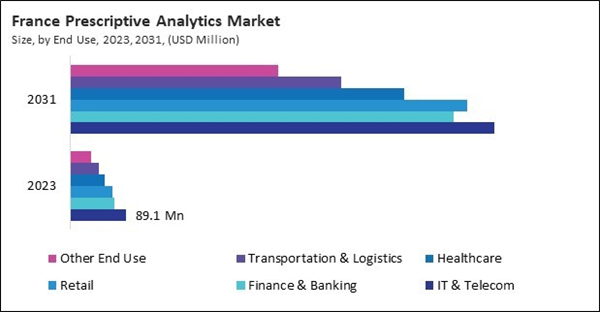The Germany market dominated the Europe Prescriptive Analytics Market by Country in 2023, and would continue to be a dominant market till 2031; thereby, achieving a market value of $5.03 billion by 2031. The UK market is experiencing a CAGR of 30.1% during (2024 - 2031). Additionally, The France market would experience a CAGR of 32.1% during (2024 - 2031).
Prescriptive analytics enables dynamic pricing strategies in the e-commerce and retail sectors by analyzing demand elasticity, competitor pricing, and market conditions. This approach helps businesses adjust prices in real-time to maximize revenue and maintain competitive advantage. Prescriptive analytics enhances supply chain resilience by recommending strategies to mitigate disruptions. For instance, it can recommend alternative suppliers, reroute shipments, or modify inventory levels in response to unforeseen events, like natural calamities or geopolitical issues, ensuring continuity and minimizing operational impact.
In the energy sector, prescriptive analytics helps optimize energy consumption and distribution. It can recommend adjusting energy usage patterns based on weather forecasts, peak demand times, and equipment performance, leading to cost savings and improved energy efficiency. Prescriptive analytics assists workforce management by recommending optimal employee schedules based on predicted demand, employee availability, and labor laws. This application helps organizations balance staffing levels, reduce labor costs, and ensure adequate coverage during peak times.
Sweden’s smart manufacturing sector heavily relies on integrating advanced technologies like 3D printing, robotics, and automation. Prescriptive analytics supports this integration by analyzing data from these technologies to improve process control, enhance product quality, and optimize production schedules. The synergy between prescriptive analytics and advanced manufacturing technologies propels the growth of the prescriptive analytics market. In conclusion, the rising smart manufacturing and expansion of the transportation industry in the region are driving the market’s growth.
Based on End Use, the market is segmented into IT & Telecom, Finance & Banking, Retail, Healthcare, Transportation & Logistics, and Other End Use. Based on Application, the market is segmented into Supply Chain Management, Risk Management, Operations Management, Marketing & Sales, Revenue Management, and Other Application. Based on Component, the market is segmented into Software and Services. Based on countries, the market is segmented into Germany, UK, France, Russia, Spain, Italy, and Rest of Europe.
List of Key Companies Profiled
- Accenture PLC
- Amazon Web Services, Inc. (Amazon.com, Inc.)
- IBM Corporation
- Microsoft Corporation
- Oracle Corporation
- SAP SE
- SAS Institute Inc.
- Sisense, Inc.
- Cloudera, Inc.
- Alteryx, Inc.
Market Report Segmentation
By End Use
- IT & Telecom
- Finance & Banking
- Retail
- Healthcare
- Transportation & Logistics
- Other End Use
By Application
- Supply Chain Management
- Risk Management
- Operations Management
- Marketing & Sales
- Revenue Management
- Other Application
By Component
- Software
- Services
By Country
- Germany
- UK
- France
- Russia
- Spain
- Italy
- Rest of Europe
Table of Contents
Companies Mentioned
- Accenture PLC
- Amazon Web Services, Inc. (Amazon.com, Inc.)
- IBM Corporation
- Microsoft Corporation
- Oracle Corporation
- SAP SE
- SAS Institute Inc.
- Sisense, Inc.
- Cloudera, Inc.
- Alteryx, Inc.
Methodology

LOADING...









